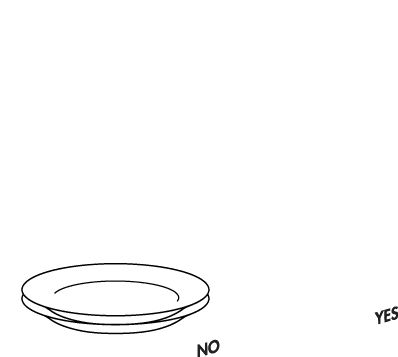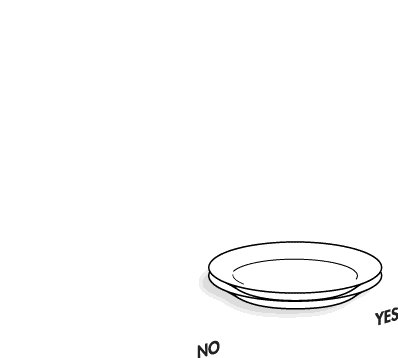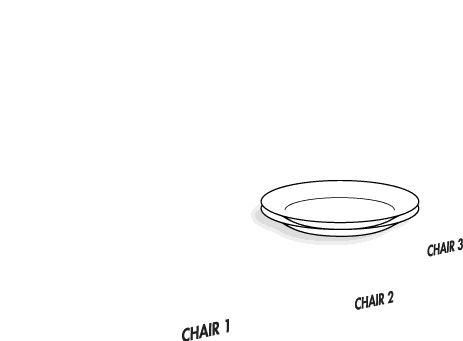Gradually, the people enter the entreprise restaurant. They take a tray and put different dishes on it. They make their way to the cashier in order to pay. They are given a receipt which is slightly different than usual. After the normal information is printed a question related to the life within the entreprise.

They choose a table, sit down, eat and discuss with their colleagues. When their lunch is over, they clear their tray and put their plate on the pile corresponding to their own answer to the question mentioned on the receipt.

When everybody has left the canteen, each pile of plates is counted and the result translated in percentage. The result will be printed the next time on the receipts together with a new question.





and so on...
As designers, we have been invited by the Ministry of Social Affairs and Employment in Holland to think about the Design4All concept. The issues raised by D4All are so diverse and numerous that it felt as an evidence to us that our task was to make people aware of these ideas, working in a preventive way instead of trying to find a particular answer to a specific problem. However, our concern about this prevention scheme was to find a more tactile and experimental answer than a conventional publication. Early in our working process, we got convinced that our challenge was to imagine a device, which placed between employers and employees, would stimulate and facilitate a dialogue essentially based on work topics. It appeared to us that workplaces themselves were the best locations to engage this discussion. Going in this direction, our aim was to ventilate frustrations, trying to defuse eventual dissensions and disenchanted feelings.
Canteens, enterprise restaurants are dream places where designers can intervene. They are the popular and social places in most enterprises where workers can sit down, discuss and relax during lunch break. Specific interventions or events are most likely to be seen and received in those places. While thinking about the way to interact in this place, we constantly kept in mind that our device should be integrated to the space as much as possible. One of our priorities for this project was to involve people without perturbing their normal behavior.
Our solution to this brief is to reconsider the role that the familiar objects usually play in the canteen. Through these objects, people get the possibility to raise their voice. This is our scenario: Gradually, the enterprise staff enter the canteen. They take a tray and put the different proposed dishes on it. They make their way to the cashier in order to pay. They are given a receipt which is slightly different than usual. After the normal information is printed a question related to the life within the enterprise. They choose a table, sit down, eat and discuss with their colleagues. When their lunch is over, they clear their tray and put their plate on the pile corresponding to their answer to the question mentioned on the receipt. When everybody has left the canteen, each pile of plates is counted and the result translated in percentage. The result will be printed the next time on the receipts together with a new question.
At the beginning of this operation, the people will be informed of this new system by an informative paper placed on each tray, explaining the reasons and the functioning of this system and giving examples of possible questions with their corresponding results. The first testing questions could be submitted as examples by the Ministry of Social Affairs and Employment. This paper will also contain a detachable part where everybody will be able to contribute by writing their own questions for the coming polls.
With this device, the common object which is the plate is given an extended use. It becomes an essential element to form a large graph made out of plates which can be read in real time according to the gradual leaving of the employees out of the canteen. In the same way, the usual receipt gets more informative. The combination of the different informations printed on it makes it a good source of recording. The possibility of collecting them can transcribe the history of this question-answer system thanks to the association of the different informations like the date, the price, the statistics, the question and also the name of the dishes for those gifted with a gustative memory.
One of the positive things about this system is that it is not intrusive. It takes advantage of the fact that people are already sitting together, discussing or resting to introduce some questions as a feeding to their conversations. The simple fact of putting one’s plate on either pile or another is not more constraining that throwing away a glass bottle in a glass container. It is an everyday gesture that can be added to our everyday habits. More, this simple act can express a point of view and when repeated by other people, communicate a general feeling. Another good side of this project is that it allows both employers and employees to submit questions. This design solution empowers employees by giving them a mode of expressing themselves about the place where they work, but also gives a tool to employers to get instructed and informed by their employees. As the dialogue goes in both directions, we could say that the system One plate/one voice is a simple and easy democratic device. This open question-answer conversation prevents the one-side moaning and the angry protest. The easy functioning mode allows a great flexibility in the questioning. The written questions can get more and more acute from day to day to get a good understanding of a problem.
The description of this method needs probably more words than seconds to make it work. The strenght of this project is that it is highly feasible in a large range of enterprises at a very low cost. It can also be applied in a very short time due to the minimal external intervention.
client: Ministry of Social Affairs and Employment, Netherlands